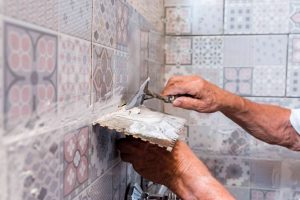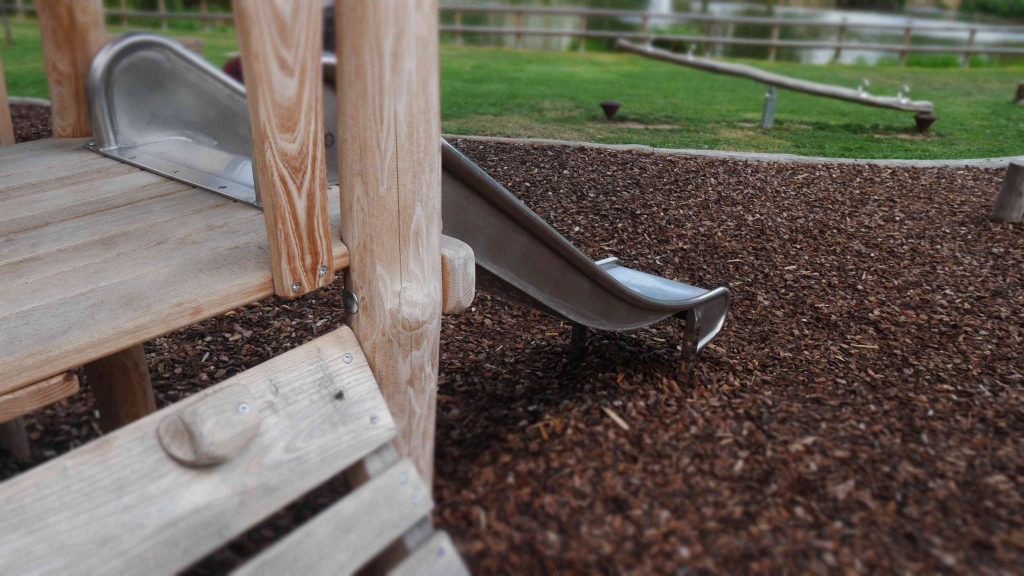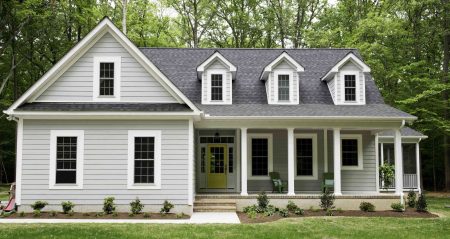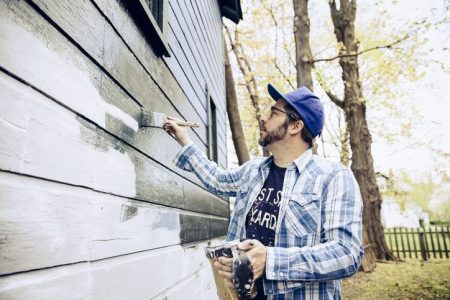An outdoor or indoor slide means hours of enjoyment for children. If your child is over two years of age and gravitates towards slides, there’s nothing better than building one yourself that’s safe and sturdy. When you build a DIY slide for the outdoor playground, the kids and their friends can entertain themselves. It’s a simple project that can be completed in just a few days for less than $500 and uses plastic and wood as the best materials for this job. For added fun, you may want an indoor slide, as well. If you have a staircase, you have an indoor slide waiting to be created. All it takes is a sheet of 3/4-inch melamine-faced MDF board, foam pipe insulation, and optional mending plates.
Outdoor Slide Building Tips
Outdoor slides take a beating from rain, sun, snow, and of course, from all of that play. Most do-it-yourselfers who build outdoor slides generally find it easiest and safest for the kids to purchase a plastic slide, then build a structure to support it. You can adapt this project to a straight or curved slide. Just note that a curved slide is faster than a straight one since it’s steeper at the top which accelerates the body down the slide.
Plastic slides alone start at about $130. The DIY slide structure is 16 square feet, measuring 4 feet by 4 feet. Plastic slides are best mounted at 5 feet high, so the deck of the slide structure too will be 5 feet high. Consider a plastic slide with a substantial platform or “leg” at the bottom edge that will raise the slide so it’s not so steep, and provide a seat at the end so the child won’t land bottom first onto the ground. This slide is high enough that you’ll need to build balusters and hand railings to keep everyone safe.
What You’ll Need
Equipment / Tools
Tools for Outdoor Slide
- Circular saw
- Miter saw
- Cordless drill
- Speed Square
- Bubble level
- Post hole digger or a power auger
- Flat shovel
- Garden hose
Tools for Indoor Slide
- Table or circular saw
- Drill or screwdriver
Materials
Supplies for Outdoor Slide
- 4 four-by-fours, each 8-foot
- 6 two-by-sixes
- 20 two-by-fours
- Concrete
- Gravel
- Deck screws
Supplies for Indoor Slide
- 3/4-inch MDF
- Foam pipe insulation
- Mending plates
- L-shaped metal corner braces
- Screws
Instructions
How To Build an Outdoor DIY Slide
-
Plan Your DIY Slide
The DIY slide should be located near the house. Maintain a buffer zone of at least 12 feet around the slide structure, since the plastic slide will horizontally extend 80 to 90 inches.
-
Check for Utilities
Contact your local utility location service. They will visit your yard and mark off vital services with water-soluble paint. This service is usually free.
-
Remove Grass
If the slide is to be located on grass, remove the turf with the flat shovel. Once the turf is gone, use a two-by-four with the bubble level to check for evenness. Scrape away high areas and add extra dirt to low areas.
-
Mark Post Locations
Mark the locations of the posts with four stakes located 4 feet away from each other. Check for square by measuring one diagonal against the other.
-
Dig Holes
Use the post-hole digger or a power auger to dig four post holes. The holes should be below your area’s frost line, typically between 36 and 42 inches. Dig another 4 inches down to accommodate the gravel.
-
Pour Gravel
Each post hole receives about 4 inches of gravel to promote drainage.
-
Plumb Posts
Set the 8-foot four-by-fours in the post holes. Add concrete, filling the holes to about 3 inches below ground level. Stabilize each post by staking it to the ground. Use the bubble level to plumb each post.
-
Attach Floor Bracing
Cut two of the two-by-sixes in half. Use these four pieces to create a square-shaped brace around the four-by-fours. Make sure that the top of this brace is at the 5-foot level and that it is level all around. There will be excess four-by-four wood above the brace, but you can cut this off after the concrete has hardened.
-
Add Water to Concrete
Use the garden hose to fill each hole with water. The water will drain through the dry concrete. When each hole is full of water, stop adding water. Wait a day or two for the concrete to harden.
-
Add Flooring
Cut four of the two-by-sixes in half. Install the resulting eight pieces of two-by-sixes flat across the top of the platform. Firmly screw each side into place with three deck screws.
-
Add Slide
Attach the slide to the upper bracing, so that the top of the slide matches the level of the flooring.
-
Add Ladder
Make a ladder from two 5-foot two-by-fours as the vertical rails and four 2-foot two-by-fours as rungs. Use screws to construct the ladder. Attach the ladder to the side of the slide structure.
-
Build Handrail
Mount the handrail at least 36 inches high, with vertical balusters running between the floor and bottom of the handrail. Balusters should be no more than 4 inches apart from each other. Leave a cut-out area for the slide and for the ladder. Build the handrail and balusters from two-by-fours.
How to Make an Indoor DIY Slide
-
Cut MDF
With a table saw or circular saw, cut the MDF lengthwise to 18 inches wide.
For a slide longer than 8 feet, cut additional 18-inch sheets.
-
Attach Sheets
Attach the sheets end-to-end with mending plates. Screw the mending plates in place from below.
-
Create the Base
Use waste material from the MDF sheet to cut fillers for the small triangle sections created by the stair treads and risers and the slide.
Attach the stair fillers to the slide from the inside with L-shaped metal corner braces.
-
Attach Pipe Insulation Foam
Separate the pipe insulation on the perforation. Fit it over the edge of the slide. Screw it into place from the side.
FAQ-
How steep should a slide be?
Getting the right angle for a DIY outdoor slide is tricky. Playground slide manufacturers adhere to safety standards and regulations, typically aiming for a 30-degree slide to appeal to all ages, and they also know that a 45-degree angle is often considered too steep, which can make kids slide dangerously fast. So you don’t want your slide to be too steep or too level; aim for between a safe 30-degree angle to a slightly steeper 40-degree slope. This project calls for a 90-inch long slide to be attached to a 5-foot high deck. A longer slide will reduce the slope. But also, consider a slide with a molded-in platform or leg at the bottom of the slide that lifts it up a bit so when a child reaches the bottom, they don’t land directly on the ground. If the platform is not high enough or the slope is still too steep, you can always build a small wooden box-style platform to raise the bottom end of the slide to reduce the slope.
-
What can you put on a slide to make it slippery?
A slow slide isn’t much fun, but a slide that’s too slippery could be uncomfortable on the backside, scary, and the child could fly down too fast and end with a thud on the ground. To make a plastic slide slippery, clean it and sand deep grooves. Then either polish the surface with wax paper or lightly coat the surface with automotive wax spray.
-
How much does it cost to build a slide?
The parts and supplies needed to make a cheap homemade slide cost a few hundred dollars, but this can be substantially less expensive than buying a premade set. The cost of a plastic slide piece itself can vary depending on its length and design. Some basic straight models are as low as around $130 while enclosed winding tunnel models can cost several hundred dollars. Buying a premade model can cost double or more than a DIY version and it will still entail the cost and time to be installed.
-
Read the full article here














